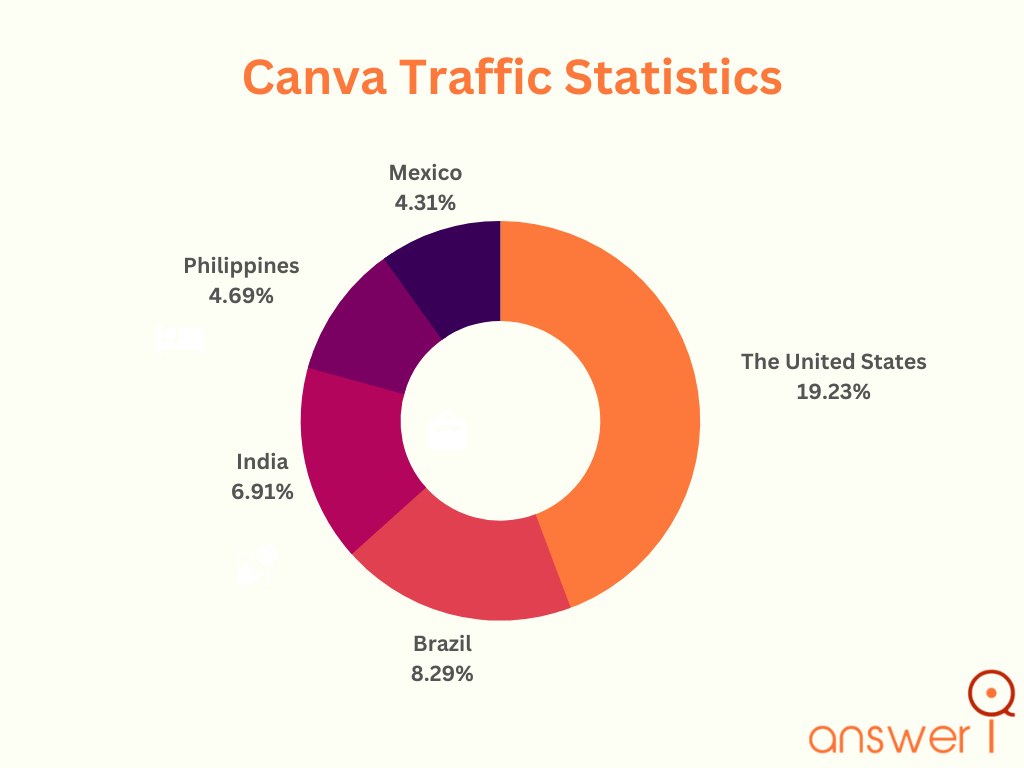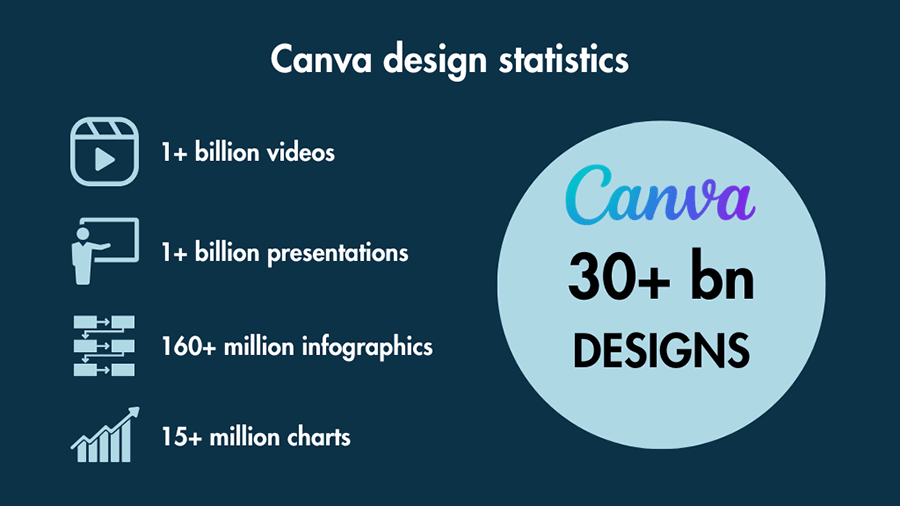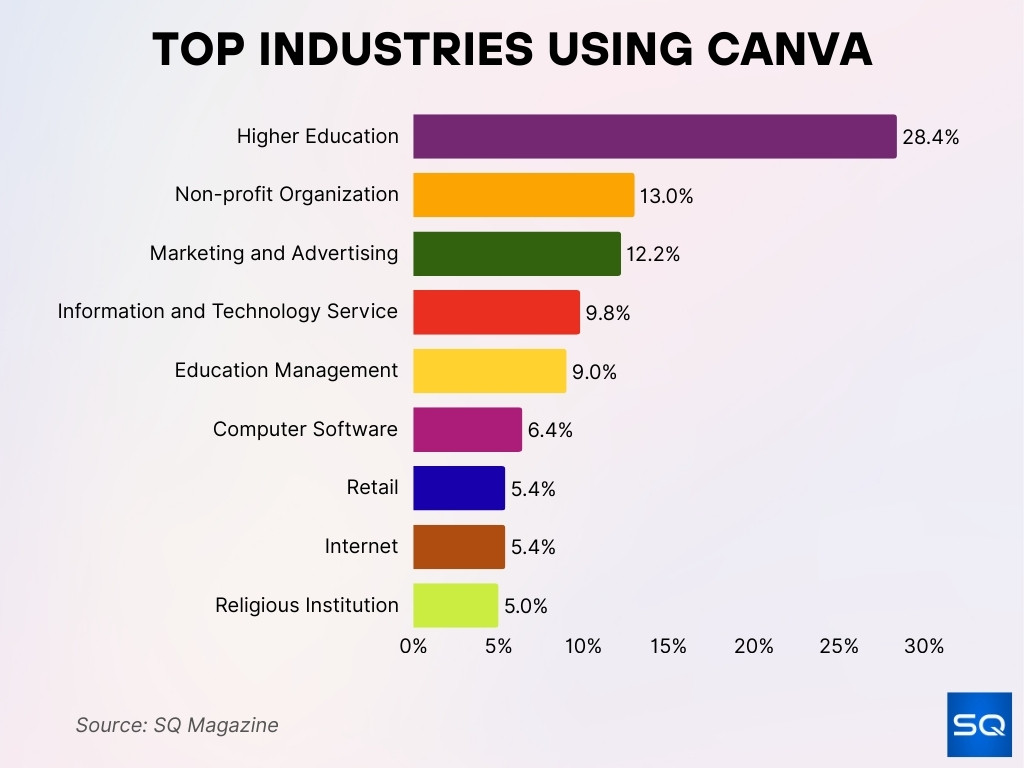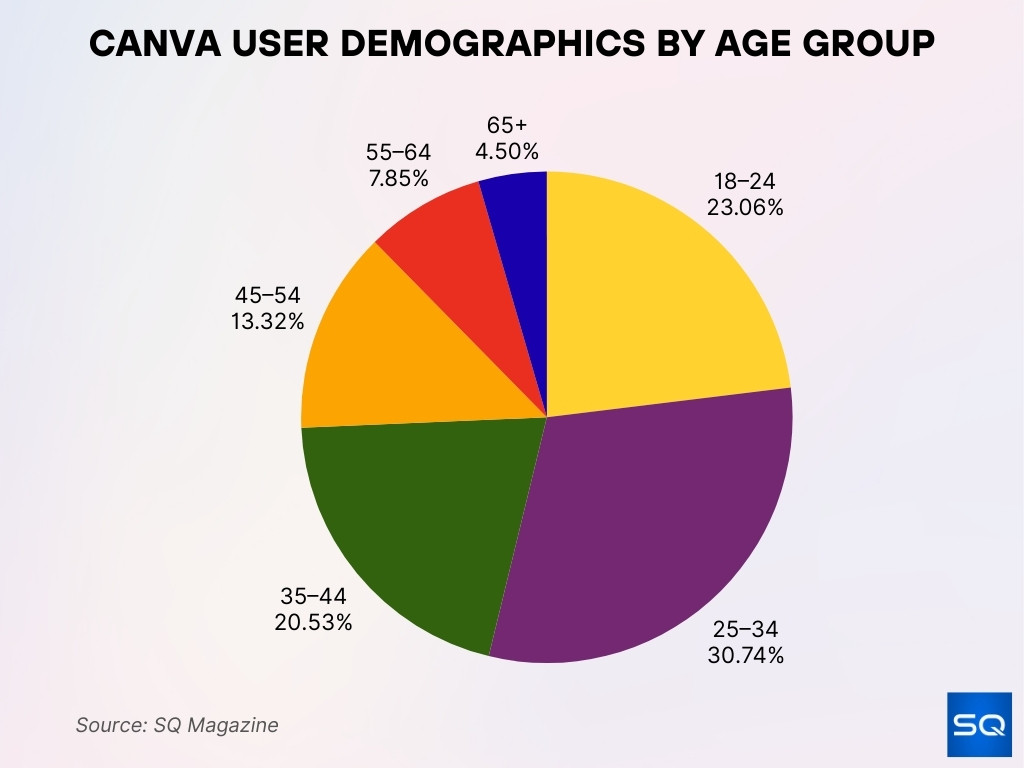Canva has redefined how people create visual content, from classrooms and boardrooms to startups and enterprise teams. What began as a tool for non-designers has become a cornerstone for marketers, educators, and even developers. Today, Canva powers everything from pitch decks to TikToks, making design more accessible across generations and industries. Whether you’re a business leader analyzing ROI or a student presenting in class, these up-to-date statistics will show why Canva remains an indispensable design platform.
Editor’s Choice
- 240 million+ people use Canva each month, a major leap from 135 million in 2023.
- Canva’s 2025 valuation sits at $42 billion, up from $25 billion two years ago.
- Over 35 billion designs have been created on Canva to date.
- Canva now serves over 190 countries, with full platform support in 100 languages.
- Canva holds an estimated 54.09% share of the online presentation software market.
- Canva for Education supports a global community of over 100 million verified teachers, students, and education leaders, though active monthly usage may vary.
- The company generates $3.3 billion in annual revenue, with consistent profitability.
Recent Developments
- In 2024, Canva launched Magic Studio, a set of AI tools including Magic Write, Magic Design, and Magic Animate.
- Canva introduced Visual Suite 2.0, combining Docs, Whiteboards, Websites, Presentations, and AI tools into a unified workspace.
- Canva Sheets, the platform’s new spreadsheet tool, integrates storytelling and design into data workflows.
- In late 2024, Canva released Canva Code, enabling users to generate interactive applications through natural language.
- Canva acquired MagicBrief and Affirm.ai in 2024 to enhance AI-powered storytelling and team collaboration.
- As of early 2025, the Canva App Marketplace features more than 1,000 apps and integrations, including Slack, Google Drive, and Microsoft Teams.
- New developer APIs support third-party widget creation, further expanding Canva’s extensibility.
- Canva debuted Brand Kits 2.0, helping enterprises enforce brand guidelines across global teams.
- The platform has launched accessibility tools, including auto-generated alt text and AI-generated language translations.
Canva Traffic Statistics
- The United States leads Canva traffic with 19.23% of total visits.
- Brazil ranks second, contributing 8.29% of overall traffic.
- India follows closely with 6.91% of Canva’s user visits.
- The Philippines accounts for 4.69%, showing strong adoption in Southeast Asia.
- Mexico contributes 4.31%, rounding out the top five traffic sources.

Canva Overview
- Founded in 2013 by Melanie Perkins, Cliff Obrecht, and Cameron Adams, Canva is headquartered in Sydney, Australia.
- It has evolved from a simple design tool to a multi-suite platform with support for docs, presentations, websites, and code.
- Canva supports over 100 languages and offers platform-wide localization for global users.
- The Visual Suite allows users to create and collaborate on everything from business proposals to social posts in a single workspace.
- Canva for Teams provides version control, brand kit integration, and cross-team collaboration features.
- With tools like Magic Write, Canva is deeply invested in AI-powered design and automation.
- The platform is available on web, Android, iOS, macOS, Windows, and ChromeOS.
- Canva’s growth is attributed to its intuitive UX, expansive template library, and low barrier to entry.
- Its suite of products now includes Canva Docs, Whiteboards, Magic Design, and AI Assistants.
- Canva continues to compete directly with Adobe Express, Microsoft Designer, and Google Slides.
Monthly Active Users
- As of Q1 2025, Canva serves over 240 million monthly active users, up from 135 million in 2023.
- Usage surged by 33% year-over-year, making Canva one of the fastest-growing design tools globally.
- The U.S. remains Canva’s largest market, followed by Brazil, India, Indonesia, and Mexico.
- More than 65 million users are part of Canva for Education’s global footprint.
- Canva for Teams and Enterprise segments now comprise over 25 million users.
- Monthly usage saw spikes during academic back-to-school seasons and marketing campaign peaks.
- The mobile app has crossed 200 million downloads across Android and iOS.
- Over 5 million users access Canva daily on their smartphones.
- Canva Docs has surpassed 80 million monthly active users, largely driven by Visual Suite adoption.
- Canva Code reached 3 million users in just 90 days, according to the company’s Q1 2025 usage report.
Canva Design Statistics
- Canva users have created 30+ billion total designs across the platform.
- Over 1 billion videos have been designed using Canva.
- More than 1 billion presentations have been produced.
- Canva hosts 160+ million infographics, making data visualization widely accessible.
- Users have also generated 15+ million charts, supporting analytics and reporting needs.

User Growth Trends
- Canva has grown from 30 million users in 2020 to 240 million in 2025, marking an 8x increase.
- In 2023 alone, Canva added over 60 million users, one of the largest annual jumps.
- The platform gains an average of 30,000 new users every day.
- Gen Z and Millennial creators continue to be the fastest-growing user segments.
- The launch of Canva Visual Suite drove user engagement by 22% year-over-year.
- Canva Pro subscriptions rose by 15% globally in 2024.
- India is one of Canva’s fastest-growing markets, doubling its user base in just one year.
- User stickiness remains high, with over 80% of users returning monthly.
- Canva’s expansion into enterprise and education contributed to 40% of its user growth in 2024.
- Countries like Indonesia, the Philippines, and Brazil show triple-digit growth in user onboarding.
Paid vs. Free Users
- Of Canva’s 240 million users, 27 million are paid users as of 2025.
- Canva Pro accounts for ~11% of all users, up from 8% two years ago.
- Enterprise licenses now make up 40% of paid subscribers, with usage concentrated in marketing and sales teams.
- Canva Teams pricing ranges from $14.99/month to custom enterprise pricing.
- The free plan still accounts for nearly 90% of new user signups, often converting later.
- Over 65% of Canva Pro users listed Brand Kits and Magic Resize as their top reasons for upgrading.
- Canva for Education is free for verified teachers and students, which accounts for ~25% of the total user base.
- Conversion rates from free to paid average around 4%, but jump to 8% in North America.
- Bundled team accounts are growing, especially in marketing agencies and SMBs.
Top Industries Using Canva
- Higher Education leads Canva adoption with 28.4% of usage.
- Non-profit organizations follow at 13%, showing strong reliance on design tools for advocacy.
- Marketing and Advertising account for 12.2%, highlighting Canva’s role in branding.
- Information and Technology Services make up 9.8% of users.
- Education Management contributes 9% to Canva’s industry usage.
- The computer Software industry represents 6.4% of users.
- Both the Retail and Internet industries account for 5.4%.
- Religious Institutions also utilize Canva, making up 5% of adoption.

Market Share
- Canva owns about 12.47% of the global graphic design and editing software market, trailing Adobe tools.
- In the U.S. creative software market, Canva claims around 10.26% of market share.
- In the presentation tools category specifically, Canva commands an estimated 54.09% market share.
- Canva states that over 85% of Fortune 500 companies, including Salesforce, PayPal, and Zoom, actively use the platform for design and brand management.
- Market penetration continues to rise, despite fierce competition from software veterans like Adobe and Microsoft.
Canva for Education
- Canva supports 100 million teachers, students, and education leaders on a monthly basis.
- Canva for Education reaches over 60 million active users.
- In higher education alone, users published 650 million designs last year.
- Usage of Magic Studio by university users increased 42% year-over-year.
- Educators report that Canva enhances engagement: 65% of teachers say Canva helps students engage more deeply.
- Integration with learning management systems like Canvas and Blackboard makes assignment delivery and collaboration seamless.
- Canva meets rigorous security standards, SOC2 Type II, ISO 27001, FERPA, and GDPR.
User Demographics
- 25–34-year-olds form the largest user demographic at around 30.74%.
- The 18–24 age group follows with 23.06%, while 35–44-year-olds account for 20.53%.
- Users 45–54 make up 13.32%, 55–64 about 7.85%, and those 65+ around 4.50%.

- The female share of users rose from 55% in 2022 to 60% in 2023.
- Gender distribution skews slightly female, approximately 58% female, 42% male.
Revenue and Valuation
- Canva’s annualized revenue recently surpassed $3 billion, up from about $2.4 billion in mid-2024.
- During a recent share sale, Canva was valued at $42 billion, up by $10 billion from the previous year.
- The user base grew to over 240 million monthly active users.
- There are now 27 million paid users.
- The company has remained profitable for eight consecutive years.
- Canva’s enterprise business has more than doubled, completing multiple $1M+ deals.
- Investor backing includes Fidelity, JPMorgan Asset Management, and Wellington Management.
Employee Statistics
- Canva employs approximately 5,500 people globally.
- Another estimate places employee count at just over 5,000, with 1,128 hired in 2023 and 500 in 2024.
- The workforce is globally distributed, with major offices in the U.S., London, Manila, Sydney, Wuhan, and Beijing.
- Employee numbers reflect Canva’s scale-up as it enters deeper into enterprise and AI-integrated product development.
Designs Created
- Canva users have created more than 35 billion designs to date.
- Over 10 billion of those designs were created in the past two years alone.
- In 2024, about 30 billion designs were created.
- That equals roughly 38.5 million designs per day or 420 designs per second.
- In higher education, 650 million designs were produced across classrooms and academic projects in one year.
- The cumulative volume of creations underscores Canva’s role as a central hub for visual expression and productivity.
Platform Features
- Canva now includes Visual Suite 2.0, integrating Canva Sheets, Magic Charts, Canva Code, and the One Design interface.
- The AI-powered Canva Code allows non-technical users to generate functional apps from plain-language prompts.
- Canva Sheets transforms data entry into visual storytelling.
- Acquisitions like Leonardo.AI and MagicBrief have bolstered Canva’s AI capabilities.
- Canva integrates design templates, photo/video editing, whiteboarding, and AI assistance under one unified platform.
- The platform supports over 100 languages.
- Education-specific features include LMS integrations, Brand Kits, SSO, and admin controls.
Design Analytics & Insights
- Canva provides built-in analytics, enabling owners and editors to track views and collaborators.
- 95% of Fortune 500 companies cite data storytelling through Canva as central to decision-making.
- 75% of users who work in analytics or marketing report using AI-powered tools like Magic Charts to enhance visual storytelling.
- Canva’s adoption spans over 230 million monthly users.
- Organizations using Canva for analytics saw up to 20% improvements in business performance.
- AI-assisted features like Magic Charts and Magic Write help translate raw data into engaging visual narratives.
- Canva’s analytics aim to reduce “data anxiety,” a problem where two-thirds of professionals feel uneasy handling data.
Device and Platform Usage
- Canva supports web, Android, iOS, iPadOS, macOS, Windows, ChromeOS, and Linux.
- Desktop remains dominant for detailed work, while mobile use is on the rise.
- Mobile usage accounts for roughly 40% of access, with the remainder from desktop users.
- Editors’ tools support browsers like Chrome, Firefox, Safari, and Edge.
- Canva for Education leverages both desktop and mobile for classroom flexibility.
- Visual Suite 2.0 optimizes across devices for fluid interactivity.
- The Developer Platform and apps marketplace expand device-friendly access.
Business Impact
- Used by 95% of Fortune 500 companies.
- Canva adoption led to 20% improvements in business performance.
- Enterprise business has doubled, with signed deals over $1 million.
- Canva bridges the confidence gap for professionals handling data.
- Canva’s revenue hit $3.3 billion, with a $42 billion valuation.
- Businesses report faster marketing cycles, lower creative costs, and better brand compliance.
Conclusion
Canva’s trajectory reflects a powerful blend of accessibility, innovation, and global scale. With over 240 million users, widespread enterprise adoption, and AI-powered design tools that drive measurable business gains, Canva continues to redefine how the world visualizes ideas. From engaging classrooms to boardroom decks, the platform empowers creators of all ages, skills, and geographies. As Canva sharpens its global expansion and product depth, its influence in design and data storytelling only grows. Explore the full insights above to see how Canva is reshaping visual communication.


































































